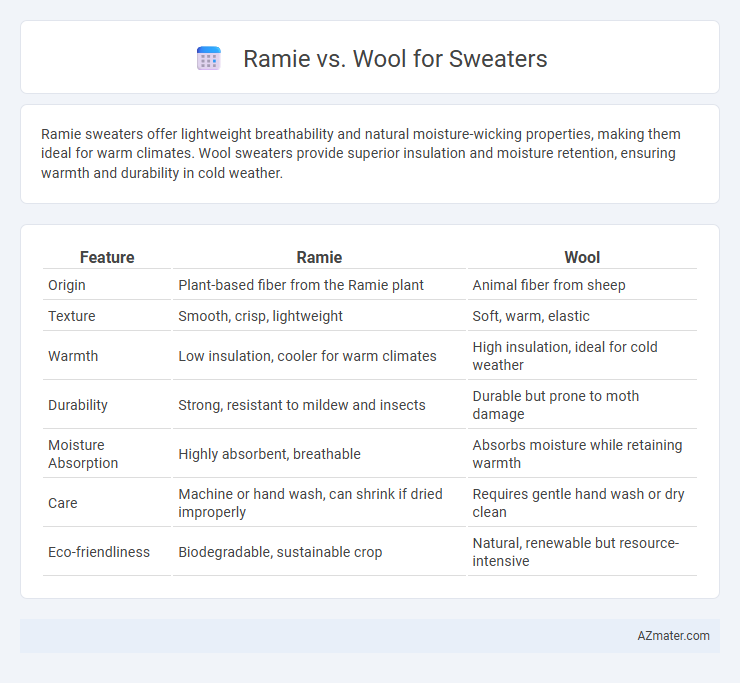Ramie sweaters offer lightweight breathability and natural moisture-wicking properties, making them ideal for warm climates. Wool sweaters provide superior insulation and moisture retention, ensuring warmth and durability in cold weather.
Table of Comparison
| Feature | Ramie | Wool |
|---|---|---|
| Origin | Plant-based fiber from the Ramie plant | Animal fiber from sheep |
| Texture | Smooth, crisp, lightweight | Soft, warm, elastic |
| Warmth | Low insulation, cooler for warm climates | High insulation, ideal for cold weather |
| Durability | Strong, resistant to mildew and insects | Durable but prone to moth damage |
| Moisture Absorption | Highly absorbent, breathable | Absorbs moisture while retaining warmth |
| Care | Machine or hand wash, can shrink if dried improperly | Requires gentle hand wash or dry clean |
| Eco-friendliness | Biodegradable, sustainable crop | Natural, renewable but resource-intensive |
Introduction to Ramie and Wool
Ramie is a natural fiber derived from the stalks of the Chinese nettle plant, known for its exceptional strength, breathability, and silky texture, making it an eco-friendly choice for lightweight sweaters. Wool, sourced mainly from sheep, offers superior insulation, elasticity, and moisture-wicking properties, providing warmth and durability ideal for cold-weather sweaters. Both fibers present unique benefits in sweater production, with ramie excelling in cool climates and wool favored for thermal comfort.
Origin and Production Processes
Ramie, derived from the stalks of the Boehmeria nivea plant native to East Asia, undergoes a labor-intensive process involving harvesting, retting, and degumming to extract its long, lustrous fibers. Wool originates from the fleece of sheep, primarily raised in regions like Australia, New Zealand, and the UK, and requires shearing, cleaning, carding, and spinning before being woven into fabric. The production of ramie emphasizes plant fiber extraction and chemical treatment, while wool production centers on animal husbandry and fiber preparation.
Physical Properties Comparison
Ramie fibers are stiff, strong, and have high tensile strength, making them durable but less elastic than wool, which offers superior softness, elasticity, and warmth retention. Wool's natural crimp enhances insulation and flexibility, while ramie is more wrinkle-resistant and mildew-resistant but lacks the loft and stretch of wool. Both fibers provide breathability, yet wool excels in moisture-wicking and thermal regulation, making it ideal for cozy sweaters.
Warmth and Insulation
Wool offers superior warmth and insulation compared to ramie, thanks to its natural lanolin content and crimped fibers that trap air effectively, providing excellent heat retention. Ramie, while breathable and moisture-wicking, lacks the insulating properties necessary for cold weather garments, making it less ideal for sweaters intended for warmth. Choosing wool ensures better thermal regulation and comfort in colder climates due to its dense fiber structure and moisture resistance.
Breathability and Moisture Wicking
Ramie fibers offer superior breathability compared to wool, making sweaters made from ramie ideal for warm weather as they allow air to circulate and keep the body cool. Wool excels in moisture-wicking by absorbing sweat and releasing it into the air, helping regulate body temperature in cooler climates. While ramie provides a lightweight, breathable option, wool's natural moisture management ensures warmth and dryness during colder conditions.
Comfort and Skin Sensitivity
Ramie fibers offer exceptional breathability and moisture-wicking properties, making ramie sweaters ideal for sensitive skin and warm climates due to their hypoallergenic nature. Wool provides excellent insulation and softness but can cause irritation or itchiness for individuals with sensitive skin or wool allergies. Choosing ramie over wool enhances comfort for those prone to skin sensitivity while maintaining lightweight durability.
Durability and Longevity
Ramie fibers exhibit exceptional durability due to their strong, linen-like structure, making them resistant to wear and tear in sweaters. Wool, known for its natural elasticity and resilience, offers excellent longevity by maintaining shape and insulating properties over time. While wool can withstand frequent use without significant degradation, ramie provides a sturdy, long-lasting option especially suitable for warm-weather sweaters.
Eco-Friendliness and Sustainability
Ramie fibers are derived from the stalks of the Chinese nettle plant, making them biodegradable and requiring fewer pesticides compared to wool, which comes from sheep and involves significant land use and methane emissions. Wool production demands more water and contributes to greenhouse gases, while ramie cultivation utilizes less water and supports sustainable farming practices. Both materials offer renewable options, but ramie's lower environmental impact and faster biodegradability position it as a more eco-friendly choice for sustainable sweaters.
Care and Maintenance Requirements
Ramie sweaters require gentle hand washing with mild detergent and air drying to prevent fiber weakening, as ramie is prone to brittleness and shrinkage. Wool sweaters demand careful washing in cold water or professional dry cleaning to maintain their natural lanolin content, which preserves softness and elasticity. Both materials benefit from proper storage in a cool, dry place away from direct sunlight to avoid damage and moth infestation.
Cost and Value for Sweater Buyers
Ramie sweaters typically offer a more affordable option compared to wool, making them attractive for budget-conscious buyers seeking sustainable and breathable fabric. Wool, while generally higher in cost, provides superior insulation, durability, and moisture-wicking properties, delivering long-term value for those investing in premium winter wear. Sweater buyers should weigh ramie's cost-effectiveness against wool's enhanced warmth and lifespan to determine the best fabric for their needs.

Infographic: Ramie vs Wool for Sweater
 azmater.com
azmater.com